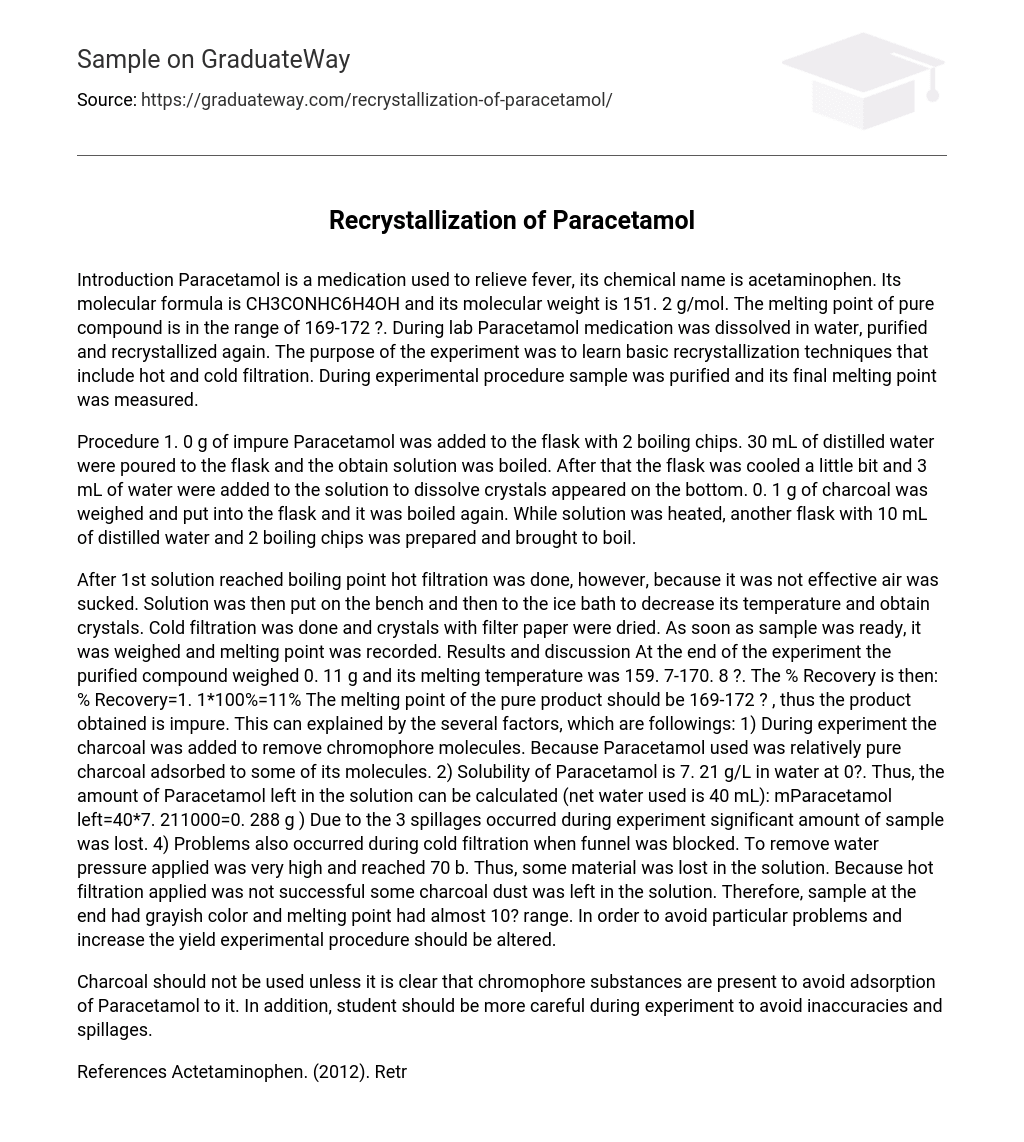Introduction Paracetamol is a medication used to relieve fever, its chemical name is acetaminophen. Its molecular formula is CH3CONHC6H4OH and its molecular weight is 151. 2 g/mol. The melting point of pure compound is in the range of 169-172 ?. During lab Paracetamol medication was dissolved in water, purified and recrystallized again. The purpose of the experiment was to learn basic recrystallization techniques that include hot and cold filtration. During experimental procedure sample was purified and its final melting point was measured.
Procedure 1. 0 g of impure Paracetamol was added to the flask with 2 boiling chips. 30 mL of distilled water were poured to the flask and the obtain solution was boiled. After that the flask was cooled a little bit and 3 mL of water were added to the solution to dissolve crystals appeared on the bottom. 0. 1 g of charcoal was weighed and put into the flask and it was boiled again. While solution was heated, another flask with 10 mL of distilled water and 2 boiling chips was prepared and brought to boil.
After 1st solution reached boiling point hot filtration was done, however, because it was not effective air was sucked. Solution was then put on the bench and then to the ice bath to decrease its temperature and obtain crystals. Cold filtration was done and crystals with filter paper were dried. As soon as sample was ready, it was weighed and melting point was recorded. Results and discussion At the end of the experiment the purified compound weighed 0. 11 g and its melting temperature was 159. 7-170. 8 ?. The % Recovery is then: % Recovery=1. 1*100%=11% The melting point of the pure product should be 169-172 ? , thus the product obtained is impure. This can explained by the several factors, which are followings: 1) During experiment the charcoal was added to remove chromophore molecules. Because Paracetamol used was relatively pure charcoal adsorbed to some of its molecules. 2) Solubility of Paracetamol is 7. 21 g/L in water at 0?. Thus, the amount of Paracetamol left in the solution can be calculated (net water used is 40 mL): mParacetamol left=40*7. 211000=0. 288 g ) Due to the 3 spillages occurred during experiment significant amount of sample was lost. 4) Problems also occurred during cold filtration when funnel was blocked. To remove water pressure applied was very high and reached 70 b. Thus, some material was lost in the solution. Because hot filtration applied was not successful some charcoal dust was left in the solution. Therefore, sample at the end had grayish color and melting point had almost 10? range. In order to avoid particular problems and increase the yield experimental procedure should be altered.
Charcoal should not be used unless it is clear that chromophore substances are present to avoid adsorption of Paracetamol to it. In addition, student should be more careful during experiment to avoid inaccuracies and spillages.
References Actetaminophen. (2012). Retrieved from: http://www. chemicalland21. com/ Granberg, R. A. , & Rasmuson, C. (1999). Solubility of Paracetamol in Pure Solvents. Journal of Chemical & Engeneering Data: 44 (6), 1391-1395• DOI: 10. 1021/je990124v





